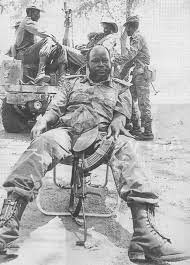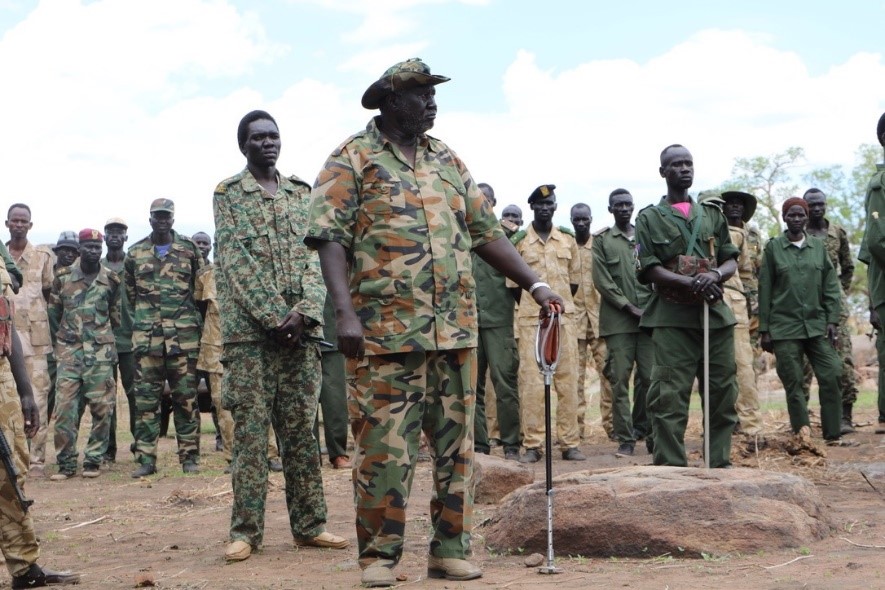Andrew McGregor
Terrorism Monitor 21(16)
August 8, 2023
When a violent struggle between the Rapid Support Forces (RSF) of General Muhammad Hamdan Daglo “Hemeti” and the Sudan Armed Forces (SAF) led by General ‘Abd al-Fatah al-Burhan broke out in mid-April, Sudan had not yet reconciled with several armed rebel movements at war with the central government for decades. With ceasefire agreements in place with most rebel movements, progress towards peace was inching along before and even after the 2019 military coup. However, the new round of national violence threatens to reignite simmering conflicts and pull existing rebel movements into a potentially devastating “third front.”
The most notable of these movements is the Sudan People’s Liberation Movement–North (SPLM–N, Harakat al-Sha’abi li-Tahrir al-Sudan al-Shamal), which in many ways represented the last vestige of Colonel John Garang’s revolutionary “New Sudan” vision for a Sudanese nation united by democracy, ethnic cooperation, and political secularism. As the intellectual and military leader of the Sudan People’s Liberation Army (SPLA) from 1985 to 2005, the US-educated Garang was able to impose his unifying vision on a movement whose Christian and animist south Sudanese members preferred separation from the rule of north Sudan’s Arab-centric Islamists rather than a union. Garang’s sudden death in a 2005 helicopter crash revealed the shallow acceptance of the “New Sudan” in southern Sudan, where even his closest comrades began to advance a separatist project that would lead to the independence of South Sudan in 2011 (Al Jazeera, August 1, 2005). Independence stranded non-Arab SPLA units in Sudan’s Southern Kordofan and Blue Nile states, which now lay on the northern side of the Sudanese divide.
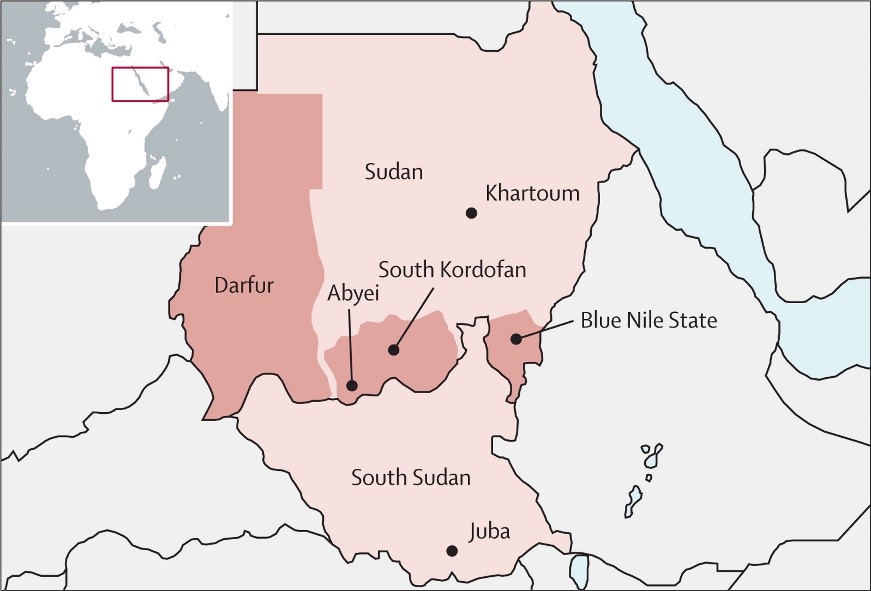 Map of Regions of Rebellion in Sudan (Lancet)
Map of Regions of Rebellion in Sudan (Lancet)
These armed units reorganized as the SPLM–N to continue the uneven fight against Sudan’s military-Islamist government and preserve the “New Sudan” ideology, sometimes in coordination with the rebel movements of Darfur. Falling victim to the factionalism that pervades Sudanese politics, the Southern Kordofan wing of the SPLM–N (under ‘Abd al-Aziz Wad Hilu) made a bitter split with the Blue Nile wing (under Malik Agar Ayer) in 2017. At the time, Agar condemned Wad Hilu for “abandoning” the New Sudan project (Sudan Tribune, August 27, 2022). Since Agar joined the SAF-dominated Transitional Sovereignty Council (TSC) that ruled Sudan in 2021, it is his former deputy Yasir Arman (an Arab of the influential Ja’alin tribe) who has become the leading adherent of the New Sudan vision, which he feels the rest of the country is finally ready for, following the 2019 popular uprising.
The Juba Agreement—A Step Towards Reconciliation
The Juba Peace Agreement of August 2020 (mediated by South Sudanese president Salva Kiir Mayardit, John Garang’s former deputy) offered the Sudanese rebel movements posts in national and regional governments, economic rights, land titles, and integration into the security forces. It did not, however, call for the disarmament of signatory groups until national elections were held. Signatories included two powerful groups from Darfur, the Justice and Equality Movement (JEM, led by Jibril Ibrahim) and the largely Zaghawa Sudan Liberation Army-Minni Minnawi (SLA–MM, led by Sulayman Arcua “Minni” Minnawi, now governor of Darfur). The largely Fur faction of the SLA led by ‘Abd al-Wahid Nur (SLA–AW) declined to sign the agreement. The Sudan People’s Liberation Movement–North (SPLM–N) were divided over the agreement, with Malik Agar’s Blue Nile faction signing on while ‘Abd al-Aziz Wad Hilu refused, citing the need to first make Sudan a secular rather than an Islamic state.
After Hemeti lost his position on Sudan’s TSC as a consequence of the RSF rebellion, TSC chairman General ‘Abd al-Fatah Burhan replaced him with Malik Agar, who had already joined the Sovereignty Council in February 2021 (SUNA, May 20). Increasingly distant from his SPLA roots, Agar has become one of the most prominent diplomatic representatives of al-Burhan’s rule.
Malik Agar—From Rebel to Vice President
Malik Agar is a member of the Ingassana, a Black African tribe inhabiting the boulder-strewn hills of the Blue Nile region, though years of conflict have forced many Ingassana to live as refugees in South Sudan. Since joining the Sovereignty Council, Agar has established close ties with General al-Burhan, but is also known to have had good relations with General Hemeti before April’s outbreak of hostilities.
Many SPLM–N members became alarmed when Malik Agar used the newfound authority granted to him by the Juba Agreement to award most government posts in the region, including the governorship, to members of his own Ingassana people, a minority group that played little role in the armed struggle against Khartoum. Increasingly unpopular in his home region, Agar sought new opportunities through his role as a member of the ruling Sovereignty Council and growing alignment with Generals al-Burhan and Hemeti in Khartoum. Agar rejected popular opposition to the October 25, 2019 military coup d’état that overthrew the civilian-military transitional regime established in September 2019. Agar stated at the time that, “What is happening in Sudan is chaos and terrorism against the state, and I do not call it a revolution” (Sudan Tribune, October 26, 2022).
The coup divided the rebels who had signed the Juba Agreement. Some had done quite well from the agreement, and while many government members resigned after the coup, former Darfur rebel leaders Jibril Ibrahim and Minni Minnawi (like Agar, new members of the TSC) both retained their positions (Radio Dabanga, April 11). Civilian prime minister ‘Abd Allah Hamdok appointed Jibril Ibrahim as Sudan’s finance minister on February 8, 2021, despite his associations with the military/Islamist Bashir regime.
Meanwhile, the civilian coalition known as the Forces for Freedom and Change (FFC) strongly opposed the military coup. Despite the major role played by the FFC in overthrowing the regime of President Omar al-Bashir, the ties of Malik Agar’s deputy, Yasir Arman, to the FFC annoyed Agar and contributed to their eventual split. In November 2022, an alternative coalition, the Forces for Freedom and Change–Democratic Bloc (FFC–DB), was formed from groups supporting the military coup, including JEM, the Beja High Council of east Sudan, the Democratic Unionist Party (closely associated with the Khatmiyya Sufi order), and Freedom and Change–National Consensus (FC–NC).
Yasir Sa’ad Arman—Keeping the New Sudan Alive
Some of the strongest criticism of the coup-backing rebel movements has come from the third man in the SPLM–N leadership, Yasir Arman, a Ja’alin Arab and thus related to the powerful Nile Valley Arab power base that has ruled Sudan since independence. Despite his origins, Arman opposes the traditional power structure in Sudan, becoming a close follower of John Garang and a loyal adherent to his New Sudan ideology since 1987. After the separation of the south, Arman became a leading figure in the SPLM–N, joining Malik Agar’s faction after the movement’s split in 2017.
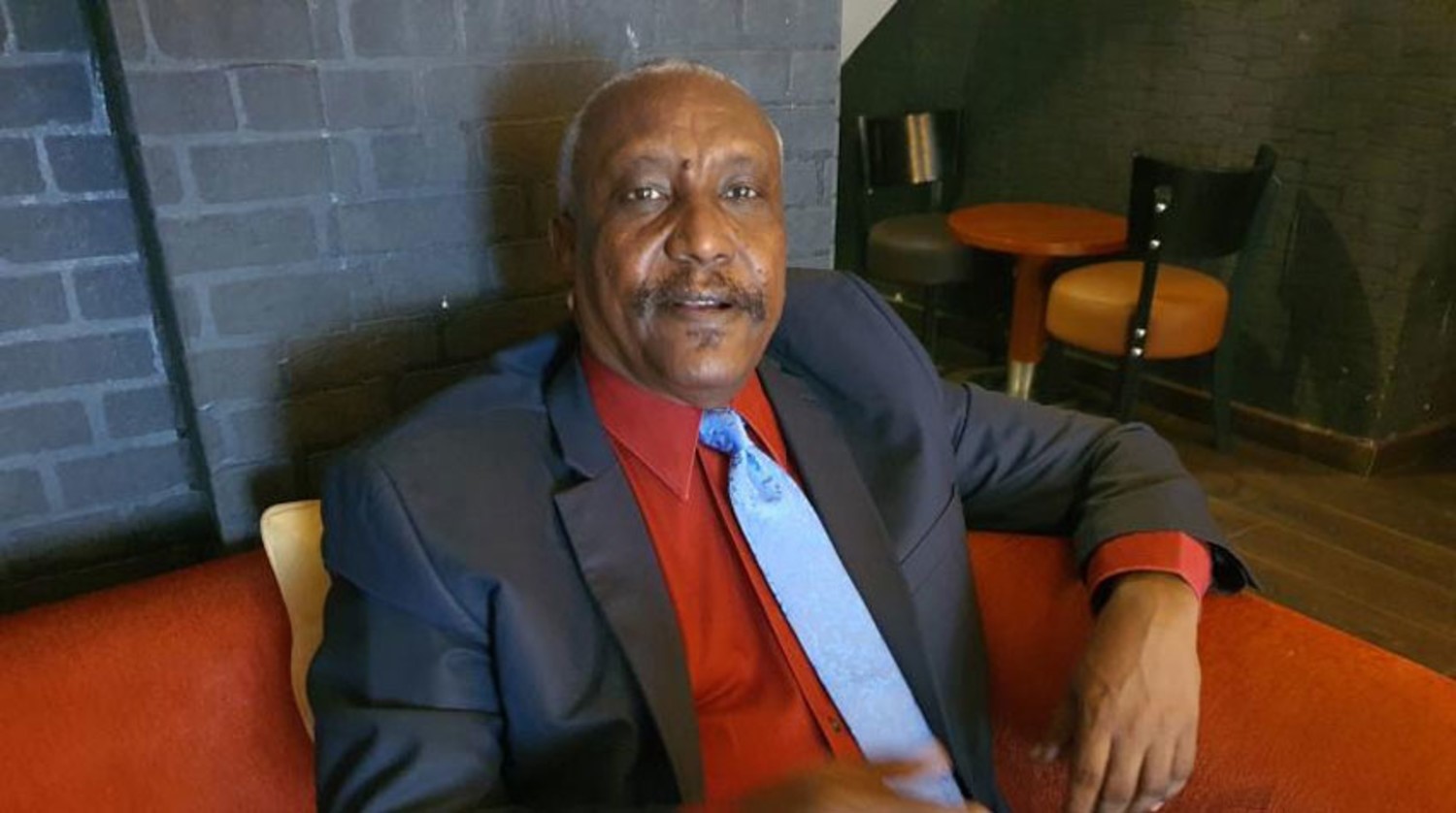 Yasir Sa’ad Arman (Asharq al-Awsat)
Yasir Sa’ad Arman (Asharq al-Awsat)
Arman and Agar had serious differences over how to proceed following the 2021 SAF/RSF military coup; while Agar is now widely viewed as being pro-coup, Arman describes the coup as a failure in every sense and fears it may provide cover for the restoration of al-Bashir’s Islamist regime (a viewpoint shared by the RSF, at least publicly). Ongoing differences led to a fissure between the two men, leading to what was described as an “amicable” split and the creation of Arman’s new movement in August 2022: the SPLM–Revolutionary Democratic Current (RDC) (Sudan Tribune, August 27, 2022). The mitosis of the SPLM–N was complete with the establishment of three related but rival movements with incompatible goals.
Arman has called for a united civilian front to move Sudan forward, with one exception: “The Islamists of the old regime who were behind and actively involved in this war should not be rewarded and involved in the process of the unified civilian front” (Sudan Tribune, June 29). Arman has elsewhere explained that “the roots of this war lie in the policy of creating multiple armies to protect [al-Bashir’s Islamist National Congress Party] system… (Sudan Tribune, June 8). Along similar lines, Malik Agar maintains that the Juba Agreement calls for a single Sudanese army, declaring that: “Having more than one army destabilizes the country” (Ahram Online [Cairo], June 22).
Political Violence Returns to the Nuba Hills
South Kordofan’s SPLM–N commander, ‘Abd al-Aziz Wad al-Hilu, is a Nuba, one of roughly 2 million in Sudan. Indigenous Black Africans, most Nuba live in the Nuba Hills of South Kordofan in remote but easily defensible communities. The Nuba speak roughly 100 languages from hill to hill, using Arabic as a lingua franca. Long subject to attacks from Arab slave-raiders, Egyptians, Mahdists, British imperialists, and Sudanese government troops, the Nuba began to develop a political identity in the later 20th century, which is best expressed today in Wad al-Hilu’s faction of the SPLM–N.
Al-Hilu is based in the town of Kauda in the Nuba Mountains, and believes Yasir Arman failed to press for the self-determination of the Nuba regions of South Kordofan, which was al-Hilu’s core demand. Complicating issues in South Kordofan is the arrival of roughly 200,000 Nuba fleeing the fighting in Khartoum. They also are all in need of humanitarian and medical assistance (Radio Dabanga, June 14).
By June 8, SPLM–N fighters began to deploy around the South Kordofan capital Kadugli, which was already subject to a blockade by RSF forces. Residents of Kadugli began to flee the city on June 21 as the SPLM–N launched attacks on positions of the SAF’s 54th Infantry Brigade around the city, although the army claimed to have repelled the attacks while inflicting heavy losses on their opponents (Facebook–General Command of the Armed Forces, June 21). SAF MiG and Sukhoi warplanes were deployed against the attackers and their bases in the hills. The SAF described the attacks as “treacherous” violations of an annually renewed ceasefire between the rebel movement and the military. The ceasefires had permitted the delivery of aid to SPLM–N-held territories and allowed the free passage of individuals in and out of these regions, but the SPLM–N claimed no pact had been broken as the ceasefires were unilateral.
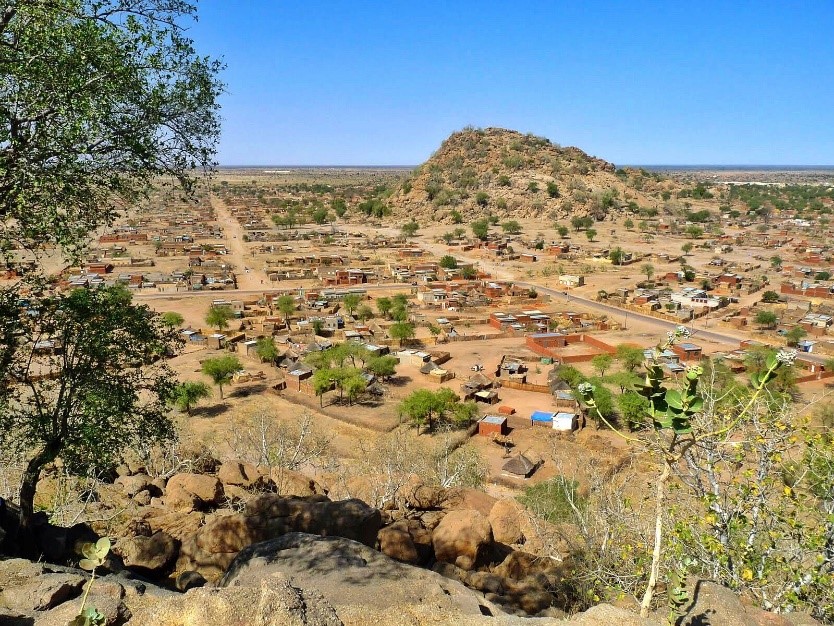 Dilling, South Kordofan (Matt Stewart)
Dilling, South Kordofan (Matt Stewart)
According to a spokesman for al-Hilu, nearly simultaneous fighting in the mainly Nuba town of Dilling began when SAF troops killed a SPLM–N fighter in a Dilling market. When SPLM–N men asked to bury the body, they were met instead with racial insults by SAF troops (Radio Dabanga, June 28). [1] On the same day as the SPLM–N attack on Dilling, the RSF reportedly seized the SAF’s Tayba military base in al-Dibaybat, which is 50 kilometers from Dilling, and took weapons, ammunition, and prisoners (al-Taghyir [Khartoum], June 21). Residents of al-Dibaybat fled the RSF occupation, fearing “immoral acts” by RSF troops and bombing from SAF warplanes (Radio Dabanga, June 23).
SPLM–N attacks on the regions around Dilling and South Kordofan capital Kadugli resumed on July 15, with the movement taking the SAF’s al-Farshaya camp near Dilling (Sudan Tribune, July 18). Once again, the strikes came at the same time as RSF attacks on the SAF’s Dilling garrison and the interception of an SAF column attempting to evacuate army personnel trapped in al-Farshaya (Radio Dabanga, July 18). SPLM–N forces also seized the Karakaya oil facility south of Dilling after its SAF guards fled. With the separation of South Sudan, South Kordofan now has Sudan’s most productive oil fields.
The SPLM–N Attack on Blue Nile State
With Agar’s influence waning in Blue Nile State, Wad Hilu has begun to pull in some of Agar’s former followers in the region despite local consequences. A two-day assault (June 25-26) by al-Hilu’s forces on the SAF-held city of Kurmuk in Blue Nile State failed to dislodge army forces but displaced nearly 36,000 people (Radio Dabanga, June 28). Al-Hilu’s men resumed attacks on Kurmuk on July 10 and seized two SAF garrisons in eastern South Kordofan (Radio Dabanga, July 11).
Fighting in the Blue Nile and South Kordofan regions is exacerbated by festering ethnic conflicts, notably Hausa versus Funj (or Birta) in Blue Nile, and Nuba versus Missiriya Arabs in South Kordofan, with the latter allegedly having support from the RSF before the current national conflict (Middle East Monitor, October 20, 2022).
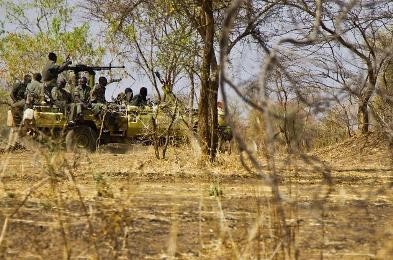 SPLM-N Patrol in South Kordofan (Sudan Tribune)
SPLM-N Patrol in South Kordofan (Sudan Tribune)
A representative of the traditional Funj people of the Blue Nile region, Obeid Muhammad Sulayman “Abu Shotal,” shares the local perception that the Hausa (originally Muslim Nigerians who settled along the pilgrimage route through Sudan in the last two centuries) are “foreigners” with no land rights in the region: “The land of Blue Nile is a red line for us … it belongs only to the original people” (AFP, August 27, 2022). [2] When Malik Agar began to grow closer to the Hausa for political purposes, the result was further alienation from his Blue Nile supporters. With hundreds of lives lost in ethnic conflict, the Sudanese army was blamed for failing to provide security in the region (Al Jazeera, October 20, 2022).
Conclusion
The SPLM–N attacks on the SAF are allegedly intended to help protect the civilian population from RSF attacks where the SAF cannot. According to an SPLM-N official:
The SPLM–N is the people’s movement and it has the right and responsibilities to protect lives and properties of the people under its control. This is what is happening in South Kordofan and Blue Nile areas … they are protecting our own legitimate territory (Sudan Tribune, July 20).
The question is whether the SPLM–N is working in league with the RSF, a group with which the rebels have had a tense relationship in the past. So far, there are no reports of the SPLM–N clashing with the RSF, although this could change quickly in the insecure environment. In the meantime, it is worth watching to see whether an apparent coordination of attacks continues. Even if unintentional, SPLM–N military activity could support RSF operations by weakening the SAF. Any expansion of SPLM–N controlled territories will strengthen their hand when, and if, peace talks ever resume in this shattered but resilient nation.
Since April, the official security forces of Sudan have lost all credibility in their mission of defending the Sudanese people. However, the factionalism and opportunism of the rebel movements and their leaders contributes little to their own credibility as an alternative. The unifying principle behind Garang’s New Sudan ideology appears to be a lost cause when even its strongest supporters cannot work together.
Notes:
[1] Sudanese Arabs frequently refer to Black Africans (such as the Nuba) as abdin (slaves), a legacy of Sudan’s long history of race-based slavery. Social media has provided a home for provocative and insulting attacks on various ethnic groups in Sudan, fueling further internal violence.
[2] The Blue Nile region was part of the once powerful Funj Sultanate, 1504-1821. The sultanate was conquered by the son of Egypt’s Muhammad Ali Pasha in 1821 and was heavily raided for slaves thereafter.

